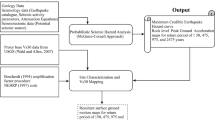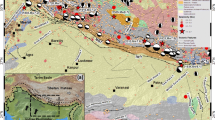Abstract
This study focuses on the field reconnaissance efforts for investigating ground deformation behavior and building foundation performance in Iskenderun. Many structures experienced significant damage or collapsed due to strong ground shaking in the coastal Iskenderun district of Hatay during the 2023 Kahramanmaras earthquake sequence. Many buildings were also impacted by ground failure due to liquefaction of deposits in the area. Preliminary information regarding the general subsurface profile and post-earthquake data collected during the reconnaissance was used to perform simplified liquefaction and lateral spreading analyses. The empirical methods provide first order estimations of settlements and lateral spreading but are not sufficient when the nature of the structure-soil-structure interaction and earthquake sequence is considered. Measurements of vertical displacements and building tilt, liquefaction manifestations, and structural and foundation parameters potentially affecting foundation settlements including foundation geometry, building contact pressure, and building elastic period were used to evaluate seismic response of the ground and the structures through empirical procedures. Most of the buildings exhibited poor to mediocre foundation performance due to liquefaction-prone subsurface profiles, especially on the coastline. Ongoing field and numerical research will reveal the cause of significant ground failure in the area as well as refined estimates for the seismic deformations.
Similar content being viewed by others
References
ASCE (2017), Minimum Design Loads and Associated Criteria for Buildings and Other Structures, American Society of Civil Engineers, USA.
Boulanger RW and Idriss IM (2014), “CPT and SPT Based Liquefaction Triggering Procedures,” Report No. UCD/CGM.-14, 1, Center for Geotechnical Modeling, Department of Civil and Environmental Engineering, University of California, Davis, CA, p. 134.
Bozkurt E (2001), “Neotectonics of Turkey–A synthesis,” Geodinamica Acta, 14: 3–30.
Bray JD and Macedo J (2017), “6th Ishihara Lecture: Simplified Procedure for Estimating Liquefaction-Induced Building Settlement,” Soil Dynamics and Earthquake Engineering, 102: 215–231.
Bray JD and Stewart JP (2000), “Damage Patterns and Foundation Performance in Adapazari,” in Kocaeli, Turkey Earthquake of August 17, 1999 Reconnaissance Report, Earthquake Spectra, 16(Suppl. A): 163–189.
BSSC (2003), NEHRP Recommended Provisions for Seismic Regulations for New Buildings and Other Structures, FEMA 450 and Building Seismic Safety Council, USA.
Eurocode 8 (2003), Design Provisions for Earthquake of Structures—Part 1–4: Strengthening and Repair of Buildings, European Prestandard ENV 1998-1-4, Comite European de Normalisation, Brussels.
Chopra AK and Goel RK (2000), “Building Period Formulas for Estimating Seismic Displacements,” Earthquake Spectra, 16(2): 533–536.
Cerna Diaz AA (2018), “Evaluation of Cyclic Behavior of Dense Sands Under Multidirectional Loading Using Centrifuge Tests,” Dissertation, University of Illinois Urbana-Champaign, USA.
Coburn A and Spence R (1992), “Earthquakes, Disasters and Protection,” Earthquake Protection, 1–31.
Dashti S, Bray JD, Pestana JM, Riemer M and Wilson D (2010), “Mechanisms of Seismically Induced Settlement of Buildings with Shallow Foundations on Liquefiable Soil,” Journal of geotechnical and geoenvironmental engineering, 136(1): 151–164.
Değerliyurt M (2014), “Settlement Suitability Analysis of Local Ground Characteristics in Iskenderun: A Case Study,” Procedia-Social and Behavioral Sciences, 120: 637–644.
Emre Ö, Duman TY, Özalp S, Şaroğlu F, Olgun Ş, Elmacı H and Çan T (2018), “Active Fault Database of Turkey,” Bulletin of Earthquake Engineering, 16(8): 3229–3275.
Gokturkler G, Berge MA, Timur E, Tuncel A and Erhann Z (2023), Iskenderun ve Antakya’da Zemin Ozelliklerinin Belirlenmesine Yonelik Jeofizik Calismalar, Dokuz Eylul University, 06 Şubat 2023 Pazarcik Elbistan (Kahramanmaras) Depremleri. (in Turkish)
Idriss IM and Boulanger RW (2006), “Semi-Empirical Procedures for Evaluating Liquefaction Potential During Earthquakes,” Soil Dynamics and Earthquake Engineering, 26(2–4): 115–130.
Kurtuluş C, Sertçelik İ, Sertçelik F, Livaoğlu H and Saş C (2020), “Investigation of Soil Characterization in Hatay Province in Turkey by Using Seismic Refraction, Multichannel Analysis of Surface Waves and Microtremor,” Earth Sciences Research Journal, 24(4): 473–484.
Maden Tetkik ve Arama Genel Müdürlüğü (MTA)(2011), Küresel ısınmaya bağlı deniz seviyesi değişimlerinin Türkiye kıyıları üzerindeki etkilerinin uzaktan algılama ve coğrafi bilgi sistemleri teknikleri ile araştırılması, Mersin-İskenderun kıyı kuşağı pilot çalışması. (in Turkish)
Over S, Büyüksaraç A, Bektas O and Filazi A (2011), “Assessment of Potential Seismic Hazard and Site Effect in Antakya (Hatay Province), SE Turkey,” Environmental Earth Sciences, 62(2): 313–326.
Ozkula G, Numanoglu O, Ilhan O, Uludag T and Baser T (2023), “Turkiye Earthquake Sequence on February 6, 2023: Preliminary Earthquake Reconnaissance Report,” Report in Turkiye & Syria Earthquake on February 6, 2023, DesignSafe-CI. https://doi.org/10.17603/ds2-htyj-5z94
Qi S (2023), “Review of Two Outstanding Compilation Works of Chinese Historical Earthquakes Literature in China,” Natural Hazards Research, https://doi.org/10.1016/j.nhres.2023.06.009
Ramirez OM, Constantinou MC, Whittaker AS, Kircher CA and Chrysostomou CZ (2002), “Elastic and Inelastic Seismic Response of Buildings with Damping Systems,” Earthquake Spectra, 18(3): 531–547.
Sancio R, Bray JD, Durgunoglu T and Onalp A (2004), “Performance of Buildings Over Liquefiable Ground in Adapazari, Turkey,” In Proc., 13th World Conf. on Earthquake Engineering, Vancouver, Canada: Canadian Association for Earthquake Engineering.
Saner T (2013), “Seismic Vulnerabilities and Risks for Urban Mitigation Planning in Turkey,” Doctoral Thesis, Middle East Technical University, p. 237, Turkey.
Sbeinati MR, Darawcheh R and Mouty M (2005), “The Historical Earthquakes of Syria: An Analysis of Large and Moderate Earthquakes from 1365 BC to 1900 AD,” Annals of Geophysics, 48(3): 347–435.
Seed HB and Idriss IM (1967), “Analysis of Soil Liquefaction: Niigata Earthquake,” Proceedings of the ASCE, Journal of the Soil Mechanics and Foundation Division, 93(3): 83–108.
Terzaghi K, Peck RB and Mesri G (1996), Soil Mechanics in Engineering Practice, John Wiley & Sons, USA.
Tokimatsu K, Kojima H, Kuwayama S, Abe A and Midorikawa S (1992), “Liquefaction-Induced Damage to Buildings in 1990 Luzon Earthquake,” Journal of Geotechnical Engineering, 120(2): 290–307.
Turkey Earthquake of August 17, 1999 Reconnaissance Report, Earthquake Spectra, 2000, 16.
Turkish Earthquake Code, TEC (2007), Specification for Buildings to be Built in Seismic Zones, Ankara, Turkey, Ministry of Public Works and Settlement, Government of the Republic of Turkey.
USGS (2023), The 2023 Kahramanmaraş, Turkey, Earthquake Sequence, USGS Geologic Hazards Science Center and Collaborators. https://earthquake.usgs.gov/storymap/index-turkey2023.html
Verderame GM, Iervolino I and Manfredi G (2010), “Elastic Period of Sub-Standard Reinforced Concrete Moment Resisting Frame Buildings,” Bulletin of Earthquake Engineering, 8: 955–972.
Youd TL, Hansen CM and Bartlett SF (2002), “Revised Multilinear Regression Equations for Prediction of Lateral Spread Displacement,” Journal of Geotechnical and Geoenvironmental Engineering, 128(12): 1007–1017.
Zhu Y, Yang X, Liu F, Zhao Y, Wei S and Zhang G (2023), “Progress and Prospect of the Time-Varying Gravity in Earthquake Prediction in the Chinese Mainland,” Frontiers in Earth Science, 11: 1124573. https://doi.org/10.3389/feart.2023.1124573
Author information
Authors and Affiliations
Corresponding author
Rights and permissions
About this article
Cite this article
Baser, T., Nawaz, K., Chung, A. et al. Ground movement patterns and shallow foundation performance in Iskenderun coastline during the 2023 Kahramanmaras earthquake sequence. Earthq. Eng. Eng. Vib. 22, 867–881 (2023). https://doi.org/10.1007/s11803-023-2205-9
Received:
Accepted:
Published:
Issue Date:
DOI: https://doi.org/10.1007/s11803-023-2205-9




